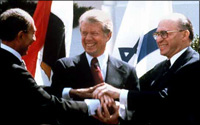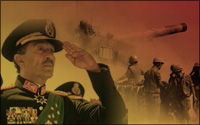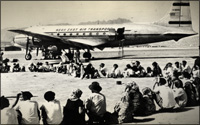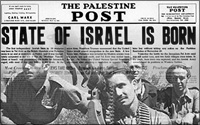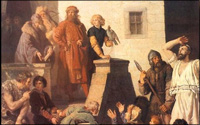 Beginning in the 1400s, the center of Jewish life shifted from Western Europe, Spain and the Mediterranean to Eastern Europe — especially Poland, Lithuania, White Russia and the Ukraine.
Beginning in the 1400s, the center of Jewish life shifted from Western Europe, Spain and the Mediterranean to Eastern Europe — especially Poland, Lithuania, White Russia and the Ukraine.
For the next 500 years, most of the creativity in Jewish life will take place in Eastern Europe, despite the fact that it will be a very inhospitable environment. We, who have witnessed the destruction of European Jewry in our time, including the Communist Revolution and the Nazi Holocaust, are nostalgic about Eastern Europe. We would like to imagine everything to have been warm, happy and nice.
However, the reality of the situation is so far different that it is mind-boggling.
While it is true that Eastern European Jewry was probably the most vital force in Jewish history — it had a religious and intellectual dynamism rarely matched in the annals of Jewish history — it also has to be recognized that they lived under often terrible conditions.
Opposite Poles
Jews had been in Eastern Europe, including Poland, as early as the 10th century. Some say they were there even earlier. But the beginning of strong immigration and Jewish life did not come about until the 1400s.
In the 1300s and 1400s, the royalty of Poland decided to allow Jews to settle in Poland in great numbers under their protection. They extended an invitation and provided Jews with certain economic benefits to entice them to come. It would be a stretch to say that the Polish royalty was pro-Jewish, because no one was, but they accepted and desired a Jewish presence.
Despite the relative enthusiasm of the Polish royalty, the masses were not as welcoming. The main opposition to a Jewish presence came from three classes of people, representing the vast majority of Poles (some 90% of the population): artisans, clergy and peasants.
The artisans, the urban town people, saw the Jews as competitors to their interests. The clergy was always bitterly anti-Semitic. Eastern European Christianity was very different than its Western European version. None of the liberalizing influences that existed in the Western European church reached Eastern Europe. Eastern Europe never experienced a Renaissance or Reformation.
In such a climate Jews were in terrible trouble. The beliefs of primitive Christianity are so steeped in anti-Semitism, Jewish guilt, claims of deicide and hatred that even when Jews were no longer around after the Holocaust they still hated them.
The Tavern Business
In the late 1800s, unemployment of Jews in Eastern Europe was as high as 40%. One-fifth of the Jewish community in Poland was reduced to begging. The economic opportunities for Jews in Eastern Europe were always minimal. And not only for Jews, but for everybody.
Nevertheless, the early Polish kings offered Jews certain unique economic opportunities when they first came to Poland. Among them was that Jews were entitled to obtain liquor licenses.
All of Eastern Europe, even today, has a strong history of alcoholism. Even in Italy or France, children can drink a whole bottle of wine at a meal. In Poland and Russia, alcoholism has been a way of life for the past 1,000 years, long before the Jews arrived. Jews were remarkably immune from the disease of alcoholism. The religious life of the Jew protected him from it — not that it was forbidden to drink, but Jew alcoholics were rare.
Alcohol was always heavily taxed by the government. The kings and noblemen of Russia and Poland saw in the increase and control of the alcohol business a chance to gain more revenue.
Even though selling alcohol became a Jewish business (although non-Jews of course engaged in it as well) it was not the type of business that would endear the tavern keeper to his patrons. People spent their last kopek on drinks and then went home with nothing to buy food for their children. They then turned the wrath for their own shortcomings onto the people that took their last kopek from them. In most cases it was the Jewish tavern owner. Whenever a pogrom started, the first place attacked was usually the tavern. It was the front line of the Jewish and non-Jewish relationship.
Serfs and Noblemen… and Jews
Like elsewhere in feudal Europe, Polish noblemen possessed large holdings of land that were subdivided among tenant farmers or serfs. The tenant farmer — who was foolish enough or had no choice — to start to work could never stop. It was like borrowing money from the mafia. The landowner of was entitled to such an exorbitant part of the crop that the poor farmer – who had to buy his seed, rent his animals, tools and the hovel he lived in — had to work next year to pay off last year’s debts.
The longer he worked the more he fell into debt. There were no bankruptcy laws, so if one did not pay back they would put him in jail… if he was lucky. If he was not lucky they killed him.
It was an unspeakable type of society. Almost 70% of Poland’s population was engaged as serfs. The one designated to collect the money and good owed the landlord and nobleman was almost always the Jew. In Polish, the saying was that every nobleman had his “Moshke,” the Polish word for Moses.
The Jew was caught in the middle. If he was decent and kind to the serf, he would not collect the rent and taxes he was supposed to and would feel the wrath of the landlord. But if did the bidding of the landlord effectively the serf resented him bitterly.
Poh-lin
Even when times were good for the Jews in Poland their economic situation was precarious. However, for most of the 500 years of Polish history the Jews were in very poor shape economically.
Despite that, they had a genuine affinity for Poland, because they felt they had a chance to develop and become strong in Poland — which they did. In fact, the Jews made a pun on the name of Poland: poh-lin – Hebrew for “here we will rest,” i.e. here we have a chance to stay.
Yiddish
The Jew in Poland and Eastern Europe distinguished himself from the non-Jew in many ways.
From the onset, the Jews in Eastern Europe kept their own distinctive Jewish dress. Almost without exception they had beards and side-curls (peyos). They looked Jewish. In Western Europe it was a badge of shame and an insult to look that way, but in Eastern Europe it became a badge of pride.
The Jew also had his own distinct language, and for 500 years never really learned the language of the land. In Germany, the Jews spoke German. In France, they spoke French. But in Poland and Eastern Europe they spoke Yiddish, a dialect similar to German.
Yiddish was more than a language. It presupposed the knowledge of the Bible, Midrash and Talmud. It presupposed a moral world. It had tremendous humor built into it. It reflected a Jewish outlook on the world and its neighbors.
Part of the tragedy of the demise Yiddish in our times is that, with its virtual disappearance, a great deal of the fiber of Judaism has been lost — not only to the unobservant but even to those that remain loyal to Torah. There is a certain feeling, an aura and understanding that could only be expressed through Yiddish. Yiddish was the repository of the Jewish soul.
The Rabbi
Most of the Jews lived in small towns in rural Europe. To be a rabbi in one of these small towns was an honor. And each town had a rabbi. It also typically had a ritual slaughterer and others necessary for a Jewish-religious infrastructure. No one was paid much. There was a lot of hunger. A rabbi’s salary might be a few kopeks a week plus a goat. In many communities, the rabbi’s salary was that his wife was given the salt monopoly or the candle monopoly.
Rabbis would compete for these jobs even though the town barely had a Jewish population of any significance! Nevertheless, the vibrancy with which every Jew’s life revolved around Torah enabled that type of situation to exist in Eastern Europe.
Learning and scholarship were always part of Jewish life, but perhaps never more than in Eastern Europe. The formal elementary school educational system in Poland was called the cheder (“room”). Jewish children went there from the age of three until bar mitzvah. There were no secular studies, and they stayed cheder all day. Consequently, in 10 years a child could gain a great deal of Torah knowledge.
Only the elite stayed after the age of bar mitzvah, because economically no one could afford it. During the average Jew’s life he would regularly come nightly to the synagogue, where classes were always held, and join different study groups. Their life revolved around the synagogue.
There were also great Torah scholars who established advanced yeshivas throughout Lithuania, Poland and Russia. The famous rabbis of Poland were revered. Torah knowledge was how a Jew’s greatness was measured. The study of Torah was developed in Eastern Europe to a degree it had never been since the days of the sealing of the Babylonian Talmud.
Council of the Four Lands
Beginning in the 1400s, the Jews in Poland enjoyed a type of governmental autonomy centered around what was originally called the Va’ad Arba Aratzos, the Council of the Four Lands (sometimes it was actually three or five lands). It was a council of elders who had been granted power by Polish royalty, in effect making the Jews an autonomous government within a government. They had the power to collect taxes and pass laws.
These laws touched on every aspect of Jewish life. There were laws about how weddings should be conducted and how disputes between Jewish communities could be adjudicated. One decree was that no Jewish woman could own a fur coat because it would raise the enmity of the non-Jewish neighbors.
Violation of a decree or law was punishable by excommunication (cherem) or formal ostracism, something the populace loathed. Such a person could not be married or buried. Today, Jews who opt out of their Jewish obligations can leave the community and go wherever they want. However, back then if one was outside the Jewish community he was absolutely nowhere. Therefore, the threat of it was very powerful weapon.
The Council of the Four Lands lasted as an effective force for almost 250 years. They met twice a year at trade fairs. The most famous trade fair was in Lublin. Jews came from all over Poland to participate in it, so the rabbis of the Council came as well and had discussions to decide on these matters. We know about many of their decrees from a book of the minutes that they kept.
A Family-Centered Life
Finally, the strength of the Jewish family was the cornerstone of Jewish survival in Eastern Europe.
Family ties, alliances and extended families all took on a great importance. The extended family was far more extensive and complex than what existed in Spain and Western Europe. In today’s society, large family units such as that are almost unknown. In Eastern Europe, it was common.
Polish Jewry would not only survive but remain vibrant for 500 years. The foundations of this success were set from the very beginning. Religious life, centering around Torah and the family, created communities built for the long haul. Life in Poland could be filled with extreme hardship, privation and even death, but at the same time exude a vitality, vivaciousness, beauty and richness that helped Jews transcend the mundane… and Polish Jewry transcend time.

